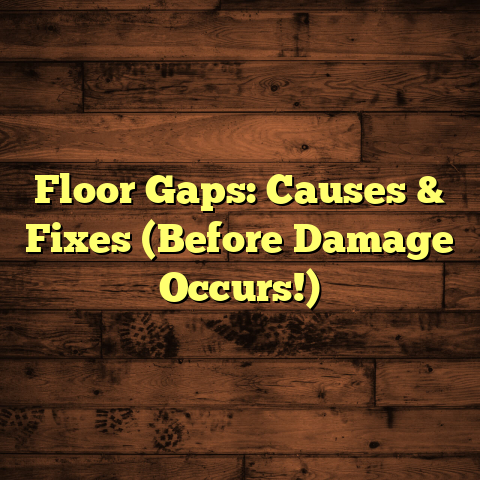Vinyl Plank Removal: Can it Be Reused? [Quick Guide]
Can you imagine giving your home a fresh look without the hefty price tag of new flooring? That’s the beauty of vinyl plank flooring. It’s versatile, stylish, and surprisingly practical. But what happens when you decide to switch things up or need to repair an area? Can vinyl plank flooring be removed and reinstalled? Let me share my experiences and insights on this topic, which has been a significant part of my flooring journey.
The Basics of Vinyl Plank Flooring
Vinyl plank flooring has gained popularity in recent years due to its durability and ease of installation. It’s designed to mimic the look of hardwood or tile while providing better moisture resistance. The interlocking mechanism allows for a simple installation process, even for someone like me who’s been in the industry for years.
When I first started working with vinyl planks, I was amazed at how many options were available. From different textures to color variations, it felt like an endless sea of possibilities. However, one question kept coming up: if I install this beautiful flooring, can I easily remove and reinstall it later?
Understanding Vinyl Plank Flooring Types
Luxury Vinyl Plank (LVP)
Luxury vinyl plank (LVP) is a premium option that features a more realistic appearance than standard vinyl. LVP is thicker and often has a textured surface that mimics real wood or stone. I’ve found that LVP works well in high-traffic areas due to its durability.
Vinyl Composite Tile (VCT)
Vinyl composite tile (VCT) is a more budget-friendly alternative. It’s made from a mixture of natural and synthetic materials, which can make it less durable than LVP but still an excellent choice for residential applications. In several of my projects, I’ve found VCT to be particularly effective in commercial spaces where costs are a significant concern.
Rigid Core Vinyl
Rigid core vinyl combines a solid core with a vinyl layer on top. This type offers additional stability and is less prone to movement during temperature fluctuations. I remember installing rigid core vinyl in a client’s sunroom, and it held up beautifully against the sunlight and heat.
Removing Vinyl Plank Flooring
Tools You’ll Need
Before tackling a removal project, gather the necessary tools:
- Utility knife
- Pry bar or pull bar
- Floor scraper
- Measuring tape
- Safety goggles
- Gloves
Having the right tools makes the process smoother and safer.
The Process
Removing vinyl plank flooring is relatively straightforward. Since most vinyl planks are designed to be floating—meaning they aren’t glued down—you can usually pull them up without damaging the subfloor.
- Start at a Corner: I often begin in a corner or along a wall where the planks are least visible. Using a utility knife, I cut through any remaining adhesive or sealant.
- Pry Up the Planks: With a pry bar, I gently lift the planks at an angle. If they’re interlocking, I might need to wiggle them a bit to release them from their positions.
- Remove Any Underlayment: If there’s an underlayment beneath the planks, I carefully peel that away too.
- Clean Up: After removing the planks, I ensure that any debris is cleared away to prepare for the next steps.
Challenges Encountered
While removing vinyl plank flooring is generally easy, I’ve encountered challenges. For instance, if the planks were glued down instead of being installed as a floating floor, removing them becomes quite labor-intensive. In one project, I had to scrape away glue residue from the subfloor, which not only took time but also required additional tools and effort.
In another case, I encountered warped planks that refused to come up easily. It took patience and careful prying to avoid damaging the underlying surface.
Reinstalling Vinyl Plank Flooring
Assessing Condition
Before reinstalling vinyl plank flooring, assess the condition of both the planks and the subfloor. If the planks are damaged or excessively worn, consider replacing them.
Preparing for Installation
- Clean the Subfloor: Make sure any dust or debris is removed.
- Inspect for Moisture: Check for moisture issues that might affect the new installation.
- Ensure Flatness: The subfloor should be level; otherwise, use a leveling compound to smooth out any imperfections.
The Installation Process
Reinstalling vinyl planks follows a similar process to the original installation:
- Lay Out the Planks: I like to lay out the planks in advance to visualize the final look. This helps avoid any surprises later.
- Start from a Corner: Just like removal, begin from a corner and work your way out.
- Locking Mechanism: Make sure each plank locks into place without gaps.
- Cutting for Fit: Occasionally, you might need to cut planks to fit around corners or edges accurately. A utility knife works well for this task.
- Finishing Touches: Once all planks are installed, reattach any baseboards or trim that were removed during the process.
Timeframe
Based on my experience, reinstalling vinyl plank flooring can typically be completed in a day or two, depending on the size of the area and any complications that arise.
This tool has become invaluable for generating realistic cost estimates based on local material and labor rates.For example, when I recently helped a client with a 1,000 square foot living room, FloorTally helped me quickly calculate costs for both removal and installation. The breakdown included:
- Material Costs: $2-$5 per square foot for vinyl planks.
- Labor Costs: $1-$3 per square foot depending on the complexity.
- Disposal Fees: If applicable, an additional $0.50 per square foot.
Using these figures allowed me to present my client with a transparent budget that included all potential expenses.
Maintenance Tips for Vinyl Plank Flooring
Proper maintenance is essential for extending the life of your vinyl flooring:
- Regular Cleaning: Sweep or vacuum regularly to prevent dirt buildup.
- Moisture Management: Avoid excessive water when mopping; too much moisture can lead to warping.
- Avoid Harsh Chemicals: Stick to mild cleaners specifically designed for vinyl floors.
- Protect from Heavy Furniture: Use furniture pads underneath heavy items to prevent dents and scratches.
- Immediate Repairs: Address any scratches or gouges promptly to keep your floor looking its best.
Comparing Options
When considering whether to remove and reinstall vinyl plank flooring, it’s helpful to compare it with other flooring materials:
- Hardwood: While beautiful, hardwood can be more expensive and challenging to remove and reinstall. Plus, it requires regular maintenance like refinishing every few years.
- Laminate: Similar in ease of installation but may not offer the same water resistance. Laminate is also susceptible to damage from moisture.
- Tile: While durable, tile installation can be labor-intensive and costly due to the need for adhesive and grout. Removing tile can also be significantly more complicated than removing vinyl plank flooring.
Vinyl plank stands out due to its affordability and versatility—making it a popular choice among homeowners and contractors alike.
Personal Anecdotes
Throughout my career as a flooring contractor, I’ve encountered countless projects involving vinyl plank flooring removal and reinstallation. One memorable job was in an older home where we had to replace water-damaged planks in the kitchen.
The homeowner was initially worried about how disruptive the process would be, especially since they had young kids at home. I assured them that we could complete the job in just one day, minimizing disruptions.
I started by removing the damaged planks while they were out at the park for a few hours. By the time they returned home, we had already laid down new planks that matched their existing floor perfectly! The look of relief on their faces was priceless as they realized their home was back in order without too much fuss.
Effective Waste Management During Removal
One aspect that often gets overlooked during flooring projects is waste management. When removing vinyl plank flooring, it’s essential to have an efficient plan for disposal.
After completing several projects where waste management was an afterthought, I learned my lesson:
- Plan Ahead: Before starting a removal project, I always call local waste management services to understand disposal options.
- Reuse Materials: If some planks are still in good condition after removal, consider reusing them in other areas or selling them online.
- Recycling: Check if local recycling centers accept vinyl materials; this can help reduce landfill waste.
By incorporating effective waste management practices into my routine, I’ve not only reduced costs but also contributed positively to environmental sustainability.
- Subfloor Problems: Sometimes when removing vinyl planks, you may discover issues with the subfloor that need addressing. This could be water damage or unevenness that requires repair before reinstalling new planks.
- Incompatible Materials: Occasionally, clients want to mix different materials in adjoining rooms (like transitioning from carpet to vinyl). Ensuring compatibility can require additional planning and adjustment.
- Color Mismatch: If you’re reinstalling planks after some time has passed since initial installation, there might be slight color variations due to fading or changes in manufacturing processes. Always check for matching products before proceeding with installation.
By approaching these unexpected issues proactively and communicating with clients throughout the process, I’ve managed to maintain trust and satisfaction even when challenges arise.
Future Trends in Vinyl Plank Flooring
As an experienced contractor, I always keep an eye on emerging trends in flooring materials:
- Sustainability: More consumers are becoming conscious of environmental impacts. Manufacturers are now producing vinyl flooring from recycled materials and focusing on sustainable practices.
- Smart Technology Integration: Some new products incorporate smart technology that can monitor temperature and humidity levels—helping homeowners manage their indoor environments better.
- Design Innovations: Advances in printing technology are enabling more realistic wood and stone looks in vinyl plank designs than ever before.
Keeping up with these trends helps me stay informed so that I can offer my clients the latest options available when discussing their flooring needs.
Final Thoughts
So, can vinyl plank flooring be removed and reinstalled? Absolutely! My experiences have shown that it’s not only feasible but also practical when done correctly. Whether you’re looking to refresh your space or address repairs, vinyl planks offer flexibility that many other flooring options don’t provide.
I hope this guide helps you feel more confident about tackling your vinyl plank flooring projects. Remember to approach each step methodically and don’t hesitate to reach out if you need advice along the way! Happy flooring!

![“Self-Leveling Concrete: How To Do It Right [DIY Guide]”](https://floortally.com/wp-content/uploads/2025/01/SelfLeveling-Concrete-How-To-Do-It-Right-DIY-Guide.png)
![Best Adhesives for Engineered Wood on Concrete [Quick Guide]](https://floortally.com/wp-content/uploads/2025/01/Best-Adhesives-For-Engineered-Wood-Flooring-On-Concrete.png)


![Parquet Floor Gap: Why It Matters [DIY Install Guide]](https://floortally.com/wp-content/uploads/2025/01/Parquet-Floor-Gap-Why-It-Matters-DIY-Install-Guide.png)
